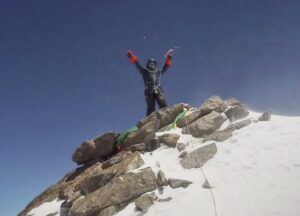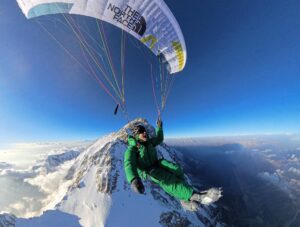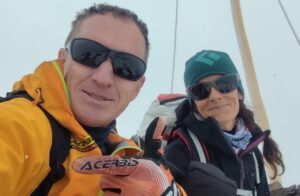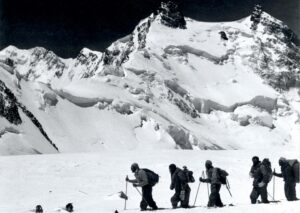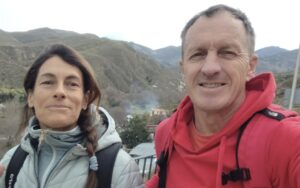Rope fixers have begun securing the lower section of the normal route of 8,125m Nanga Parbat. Some independent climbers have begun their acclimatization. On the Rupal Face, David Goettler, Boris Langenstein, and Tiphaine Duperier are progressing. Here’s the latest news from Nanga Parbat.
Horia Colibasanu has spent this week acclimatizing. The Romanian aims to summit Nanga Parbat via the Kinshofer (standard) route on the Diamir Face without supplemental oxygen or high-altitude porters.
Three days ago, he reached Camp 1 at 5,000m and overnighted there. His mattress sprung a leak overnight, and by morning he felt like he was “in a boat.” That night, about 12cm of snow fell, although temperatures remained mild at around 4–5°C.
He had intended to move higher, but conditions were too hazardous. The previous Sunday, a large avalanche had struck the couloir above the rock protecting Camp 1. So instead of risking that passage, Colibasanu descended to Base Camp to wait before attempting Camp 2.

Horia Colibasanu on the Kinshofer Route of Nanga Parbat’s Diamir Face. Photo: Horia Colibasanu
Brutal climb, brutal sun
Yesterday, that opportunity came, and Colibasanu reached Camp 2 at 6,000m.
“It was brutal — 1,800m climbed with all my gear on my back,” he wrote on social media.
He said the final 150m involved a tricky rock wall, and he found barely enough space for his tent. He managed to set it up on a two meter by one meter platform, securing it to fixed ropes to stabilize it. However, ice beneath part of the platform made leveling the tent challenging.
Sa’ad Mohamed of Pakistan also aims to summit Nanga Parbat via the Kinshofer route without supplemental oxygen or high-altitude porters. Today, he reached Camp 2 while acclimatizing, noting, “The sun is brutal up here.”
Currently, there is no news from Denis Urubko and Maria Cardell, who are attempting a new route on the Diamir Face.

The Diamir Face of Nanga Parbat from the air. Photo: Guilhem Vellut
The Rupal Face
David Goettler, Boris Langenstein, and Tiphaine Duperier are climbing the demanding Schell Route on the hazardous Rupal Face.
The trio arrived a week ago and recently climbed to 6,000m to assess conditions. They are now at Latabo Base Camp, nestled beneath the Rupal Face, awaiting a suitable weather window. The team is climbing without external support or supplemental oxygen.

The Latabo Base Camp beneath the Rupal Face. Photo: David Goettler
Goettler’s goal is to summit Nanga Parbat on this, his fifth attempt on the Rupal Face, then descend by paraglider, a feat never before accomplished. Langenstein and Duperier will ski from the summit.

Left to right, Boris Langenstein, Tiphaine Duperier, and David Goettle on the Rupal Face. Photo: David Goettler
The 1976 Schell route climb
On August 11, 1976, four Austrians — Hanns Schell (leader), Robert Schauer, Siegfried Gimpel, and Hilmar Sturm — summited Nanga Parbat via a new route, now known as the Schell Route, without supplemental oxygen. This was the fifth overall ascent of Nanga Parbat and the second ascent of the Rupal Face.

Nanga Parbat’s Rupal Face. Photo: Simone Moro
The Austrian team established Camp 1 at 5,100m in early July. After navigating rockfall and couloirs, they reached Camp 2 at 6,100m. They set up Camp 3 at 7,000m after heavy snowfall, during which they lost their cache of supplies and their tent was buried under two meters of snow.
From Camp 3, it took the Austrians four days to reach Nanga Parbat’s summit via this new route. After an eight-hour climb through deep snow, they established Camp 4 at 7,450m. On August 10, 1976, Schell’s team reached 8,042m by 7 pm but bivouacked at 8,020m due to darkness. On August 11, they finally summited, one month after leaving Base Camp.

The Schell Route on Nanga Parbat’s Rupal Face, sketched by the Polish Winter Nanga Parbat 2006-07 team, with the help of Hanns Schell. Photo: via Altitudepakistan.blogspot
In the early stages, the Austrians required fixed ropes and faced heavy snow and rockfall between Camps 1 and 2. A severe storm hit Camp 2 mid-climb, and monsoon-like rains and floods in Pakistan forced a six-day retreat to Base Camp.
Later, the weather cleared, but the snow had buried their equipment. A sudden gust nearly destroyed their Camp 3 tent. On the summit day, August 11, a storm at 8,000m forced a temporary retreat, but conditions improved by noon, with warm, clear weather at 7,700m.
Their descent, conducted between August 11 and September 5, 1976, was challenging. Schell suffered severe exhaustion and lung issues, which slowed their progress.
Current forecast on Nanga Parbat
Mountain Forecast indicates low winds at the beginning of next week. The weather for the summit and for 7,500m over the coming days is as follows:

Weather forecast by Mountain Forecast regarding the summit of Nanga Parbat.
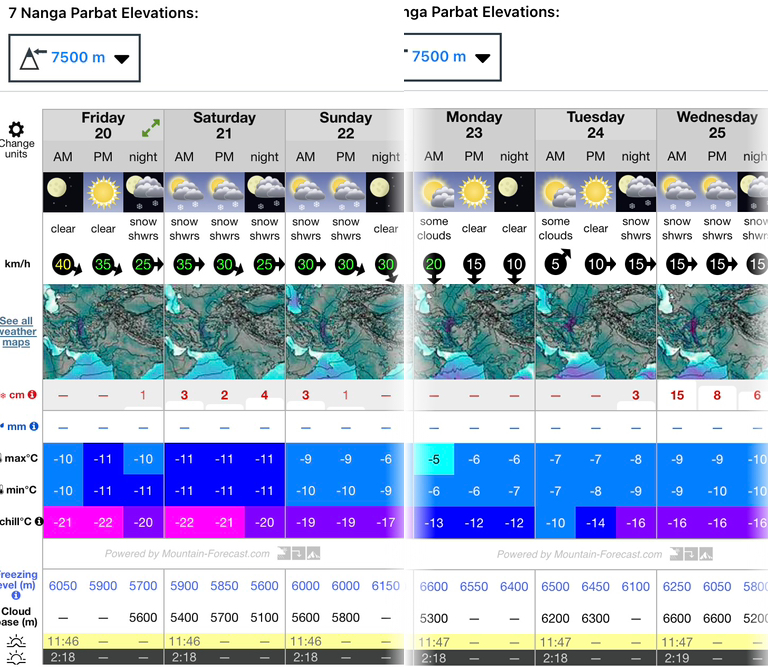
Weather forecast by Mountain Forecast at 7,500m on Nanga Parbat.

